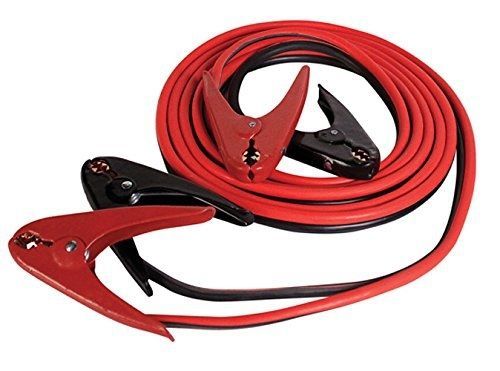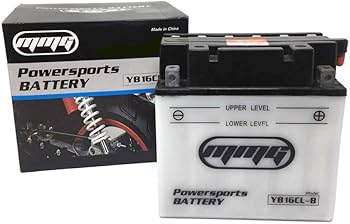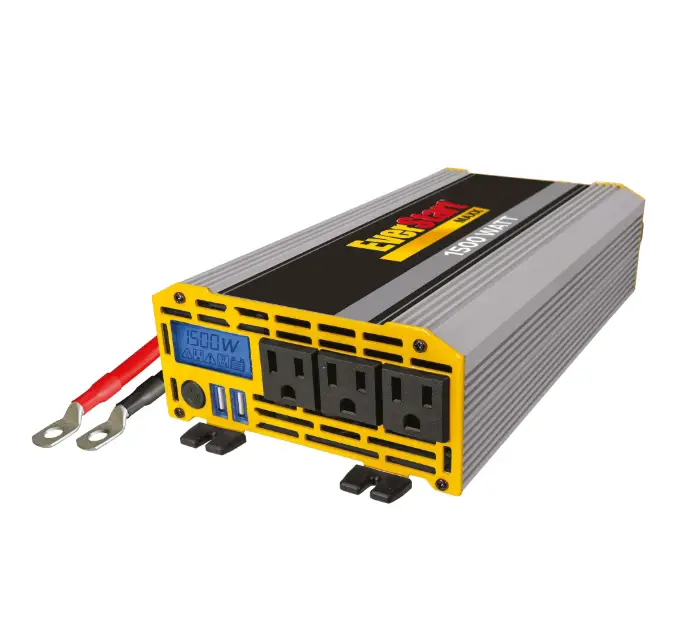
EverStart Maxx 1500 Watt Automotive Power Inverter with USB Power and Digital Display (PC1500E)- New
- Connect directly to your vehicle battery for up to 1500 watts of AC power
- Comes with pure copper O-Ring cables
- Dual USB charging ports
- Lightweight, compact aluminum housing
- ETL Certified
- New
$147.38
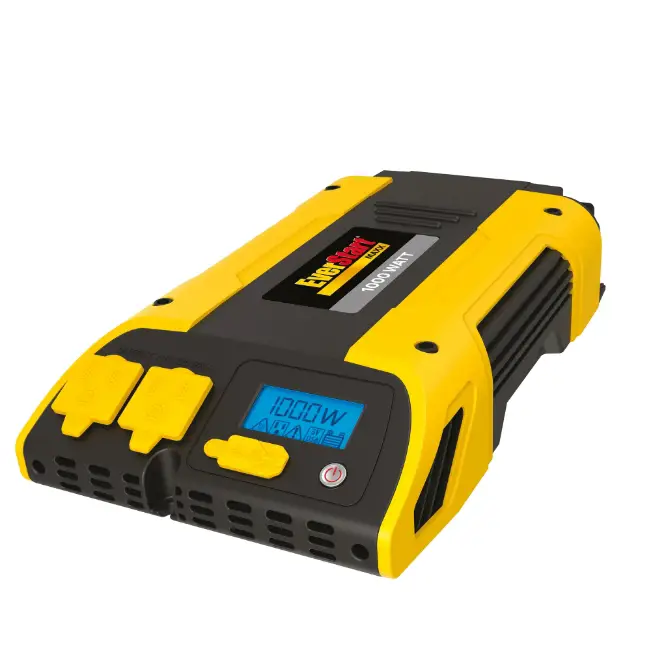
EverStart 1000 Watt Power Inverter with USB (PC1000E) in Yellow and Black
- 1000 Watts of continuous household power
- Safety features include fault indicators for short circuit, overload, thermal ground fault, and a low-voltage cutoff to prevent the inverter from draining your vehicle battery
- Dual 120 Volt AC outlets
- Single 2.1 Amp USB port
- Connects directly to your car or truck’s 12V battery
$94.98
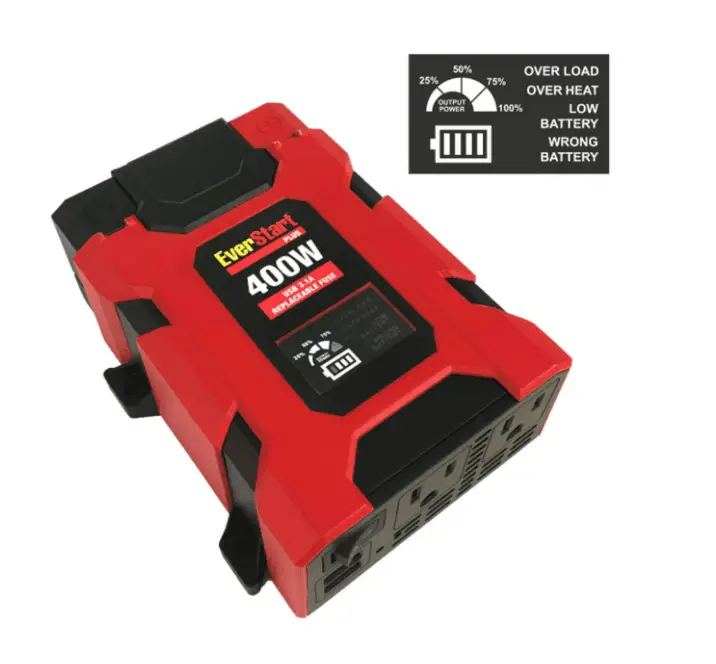
EverStart 400-Watt Continuous Wattage Power Inverter
- Portable inverter utilizes your vehicle’s power to charge small electronic devices
- Two universal USB ports compatible with iPhone, iPad, Samsung, and other mobile devices and accessories
- Two AC ports for powering or charging small electronics such as laptops, fans, or lights
- Multiple USB and AC ports allow simultaneous charging of two devices
- Safety features include protection against overcharging, shortcircuiting, and overheating
- Comes with an attached cigarette lighter plug and colorcoded cables for easy use
- Replaceable fuses conveniently stored in the end cap for quick access
- Digital display shows active power status for user convenience
- USB ports share a total of 3.1 Amps power for efficient charging
- AC ports provide a total output of 400 Watts
$29.87
As someone who has spent years traveling, camping, and dealing with power outages, I’ve come to appreciate the value of a reliable power inverter. When I purchased my first Everstart Power Inverter five years ago, I had no idea how much it would transform my ability to stay connected and powered up wherever life took me. Today, I’m sharing everything I’ve learned about these incredible devices to help you make an informed decision before your purchase.
Let me tell you, having portable power at your fingertips can be absolutely life-changing. Whether you’re a road warrior, outdoor enthusiast, or simply someone who wants to be prepared for emergencies, an Everstart Power Inverter might be exactly what you need.
What Exactly Is an Everstart Power Inverter?
Before diving into specific models and features, let’s clarify what we’re talking about. An Everstart Power Inverter is a device that converts direct current (DC) power from your vehicle’s battery or another DC source into alternating current (AC) power—the same type that powers the appliances and electronics in your home.
I remember when I first realized I needed one. I was on a cross-country road trip, trying to get some work done on my laptop while my partner drove. The laptop battery died, and I had no way to charge it until we reached our destination hours later. That’s when I understood the value of being able to use standard household electronics anywhere.
Everstart is Walmart’s automotive brand, known for offering reliable power solutions at accessible price points. Their power inverters have become popular choices for everyone from casual campers to serious preppers.
How Does an Everstart Power Inverter Actually Work?
Understanding the basics of how these devices function helped me choose the right one for my needs, so let me explain the process.
At its core, an Everstart Power Inverter performs a surprisingly complex conversion. Your car battery (and most portable power sources) provides 12V DC power. However, your household appliances require 120V AC power to function. The inverter bridges this gap through a multi-step process:
- First, it takes the 12V DC input
- Then, it converts this to a higher voltage DC current using a transformer
- Next, it switches this high-voltage DC current on and off rapidly
- Finally, it smooths out this pulsating current into a consistent AC output that mimics what comes from your wall outlet
What impressed me most when I learned about this process was the sophisticated circuitry inside these relatively compact devices. They’re engineering marvels that have become increasingly efficient and reliable over the years.
The Everstart Power Inverter Lineup: Finding Your Perfect Match
When I first started shopping for an inverter, I was overwhelmed by the options. Everstart offers several models with different capabilities, and understanding the differences is crucial for making the right choice.
Entry-Level: 100-200W Inverters
These compact models are perfect for basic needs. I started with a 150W model that plugged directly into my car’s cigarette lighter socket. It was perfect for charging my phone, tablet, and even my laptop on the go. These typically have one or two AC outlets and possibly USB ports.
The 100W version is the most portable, often small enough to fit in a glove compartment. The 200W provides a bit more power while still being cigarette lighter compatible in most vehicles.
Mid-Range: 400-500W Inverters
When I upgraded to a 500W model, I discovered a whole new world of possibilities. These mid-range options usually connect directly to your car’s battery using alligator clips or terminal connections, offering significantly more power.
With my 500W inverter, I could run small appliances like a portable fan, a small TV, or even my wife’s hair dryer (on the low setting). These mid-range models typically feature multiple AC outlets and high-output USB ports, making them versatile for family use.
Heavy-Duty: 750W+ Inverters
For serious power needs, Everstart offers models ranging from 750W to 2000W. I invested in a 1000W model for our RV, and it’s been a game-changer for our camping trips. These connect directly to a battery with heavy-duty cables and can power multiple devices simultaneously.
With these high-capacity models, you can run power tools, small microwaves, coffee makers, and even some refrigerators (though be careful with the startup power requirements, which I’ll discuss later).
Installation 101: Setting Up Your Everstart Power Inverter
Installing your inverter is relatively straightforward, but there are important safety considerations to keep in mind. Here’s my step-by-step process for different types of installations:
For Cigarette Lighter Plug Inverters (Typically 200W or Less)
This is as simple as plugging it in! However, I’ve learned a few tricks:
- Make sure your vehicle’s power outlet is rated for the amperage your inverter will draw
- Some vehicles only power the cigarette lighter when the ignition is on, so be aware of this limitation
- Keep the inverter in a well-ventilated area, as they can generate heat
For Direct Battery Connection Inverters
For my 500W and higher inverters, I had to connect directly to the battery. Here’s my process:
- Turn off your vehicle completely
- Locate the battery and identify the positive (usually red) and negative (usually black) terminals
- Connect the inverter’s red cable to the positive terminal first
- Then connect the black cable to the negative terminal
- Secure the inverter in a stable position where it won’t move during driving
- Make sure the inverter’s power switch is OFF before making connections
- Once connected, turn on the inverter and test with a small appliance
For my 1000W unit in the RV, I installed it semi-permanently, which involved running the cables through grommets and securing them with cable ties. If you’re doing a permanent installation, I recommend consulting with an automotive electrician.
Understanding Wattage: How Much Power Can Your Everstart Inverter Deliver?
This is where I made my first mistake—not understanding the difference between continuous and peak power. Let me save you from the same error!
Continuous wattage refers to how much power the inverter can provide consistently over time. This is the most important number to consider when choosing an inverter.
Peak wattage is the maximum power the inverter can provide for very short periods, typically when devices first start up. Many appliances (especially those with motors or compressors) require a surge of power when turning on.
For example, my 1000W inverter can handle 1000W continuously but has a peak capacity of 2000W for a few seconds. This extra headroom is essential for running appliances like refrigerators that have high startup power requirements.
To determine your needs, make a list of all the devices you plan to power simultaneously and add up their wattage requirements. Then add about 20% as a safety margin. Here are some common device wattages I’ve found:
- Smartphone charger: 5-10W
- Laptop: 45-90W
- CPAP machine: 30-90W
- 32″ LCD TV: 50-70W
- Small refrigerator: 50-100W running (but 300-600W startup)
- Microwave: 600-1200W
- Coffee maker: 600-1200W
- Hair dryer: 1000-1800W
Can an Everstart Power Inverter Charge My Laptop?
This was one of my primary reasons for getting an inverter, and the answer is a definite yes! Even the smallest Everstart inverters (100W) can easily handle most laptop power adapters, which typically draw 45-90W.
I’ve found that charging laptops through an inverter is nearly as efficient as using a wall outlet. The only real difference is that the inverter itself consumes a small amount of power during the conversion process, so your car’s battery will drain slightly faster than the actual power delivered to your laptop.
One tip I’ve learned: if your laptop uses a USB-C charger, consider a DC-to-USB-C adapter instead of an inverter for maximum efficiency when in your vehicle. However, the inverter gives you more flexibility to charge multiple devices.
Safety First: Is the Everstart Power Inverter Safe to Use?
Safety was a major concern for me when I started using power inverters, especially in enclosed spaces like a car or tent. After years of use, I can confirm that Everstart inverters include several important safety features:
- Overload protection: Automatically shuts down if you connect devices that exceed the inverter’s capacity
- Over-voltage protection: Prevents damage from power surges
- Thermal protection: Shuts down if the inverter gets too hot
- Low battery alarm and shutdown: Warns you when your vehicle’s battery is getting low and shuts off to prevent completely draining the battery
I’ve triggered the overload protection a few times when trying to run too many devices simultaneously, and I appreciate how the inverter shut down safely rather than risking damage or fire.
That said, I always follow these safety practices:
- Never use the inverter in wet conditions
- Ensure proper ventilation around the unit
- Keep it away from flammable materials
- Don’t use it in extremely hot environments
- Turn it off when not in use to conserve battery power
- Never modify the inverter or its cables
What Can I Power with My Everstart Inverter?
This depends entirely on the wattage of your specific model, but I’ve successfully used my various Everstart inverters to power:
With a 150W inverter:
- Smartphones and tablets
- Laptops
- LED lights
- Small fans
- Portable game consoles
- CPAP machines (most models)
With my 500W inverter:
- Everything above, plus:
- Small TVs
- Satellite receivers
- Gaming consoles
- Small kitchen appliances like blenders (used briefly)
- Portable stereo systems
With my 1000W inverter:
- Everything above, plus:
- Small microwaves
- Coffee makers
- Toasters
- Small power tools
- Electric blankets
- Small refrigerators
What I can’t run, even with my 1000W model:
- Air conditioners
- Large refrigerators
- Electric heaters
- High-powered tools like circular saws
- Washing machines
Troubleshooting Your Everstart Power Inverter
Even the best equipment sometimes has issues. Here are the common problems I’ve encountered and how I’ve resolved them:
Inverter Won’t Turn On
- Check all connections to ensure they’re secure
- Verify your battery has sufficient charge
- Check any fuses in the inverter or connection cables
- Allow the inverter to cool if it has overheated
- Try resetting by disconnecting completely, waiting 30 seconds, and reconnecting
Inverter Turns On But Won’t Power Devices
- Ensure your device’s power requirements are within the inverter’s capacity
- Try a different outlet on the inverter
- Test with a simpler device like a phone charger
- Check for any error lights on the inverter indicating a problem
Inverter Makes Unusual Noises
- A slight humming sound is normal during operation
- A loud buzzing often indicates an overload situation
- Clicking sounds usually mean the inverter is cycling on and off, possibly due to a weak battery or connection
Inverter Shuts Down Unexpectedly
- This is usually the protection circuitry doing its job
- Check for overloading (trying to power too many devices)
- Ensure adequate ventilation around the unit
- Check your vehicle’s battery voltage
- Allow the unit to cool down if it has overheated
Understanding the Warranty on Everstart Power Inverters
Everstart typically offers a one-year limited warranty on their power inverters. In my experience, Walmart (as the retailer for Everstart products) has been reasonable about honoring warranty claims when I’ve had issues.
The warranty generally covers manufacturing defects but not damage from misuse, improper installation, or normal wear and tear. I always recommend keeping your receipt and the original packaging until the warranty period expires.
For those planning to use their inverter heavily, I’ve found that purchasing Walmart’s extended protection plan can be worthwhile, especially for the higher-wattage models that represent a bigger investment.
Where to Buy an Everstart Power Inverter
As Walmart’s house brand, Everstart Power Inverters are primarily available at Walmart stores and Walmart.com. I’ve occasionally seen them at other retailers, but Walmart typically offers the best selection and pricing.
I’ve found that the in-store selection can be limited to the most popular models, while the website often has the full range available. Seasonal availability can also be a factor—these units tend to be more heavily stocked during summer camping season and before hurricane season in coastal areas.
Price-wise, I’ve seen the smaller models (100-200W) range from $20-40, mid-range units (400-500W) from $40-70, and the larger units (750W+) from $80-200, depending on specific features and power capacity.
Maintaining Your Everstart Power Inverter for Longevity
I’ve managed to keep my original 150W inverter functioning for over five years with some basic maintenance practices:
- Keep it clean: Dust and debris can interfere with cooling. I gently clean mine with compressed air occasionally.
- Check connections: Loose or corroded connections can cause performance issues and potential hazards. I inspect mine monthly if used regularly.
- Store properly: When not in use, I store my inverters in a cool, dry place, ideally in their original packaging or a protective case.
- Avoid extreme temperatures: Excessive heat or cold can damage electronic components. I never leave mine in a hot car when not in use.
- Use within rated capacity: Consistently running your inverter at maximum capacity will shorten its lifespan. I try to stay below 80% of the rated continuous power for regular use.
- Turn off when not in use: This not only conserves your vehicle’s battery but also extends the life of the inverter components.
Pros and Cons of Using an Everstart Power Inverter
After years of using various Everstart models, here’s my honest assessment of their strengths and limitations:
Pros:
- Affordable compared to premium brands
- Widely available through Walmart
- Decent build quality for the price
- Good range of power options
- Essential safety features included
- Simple to use, even for beginners
- Compact design, especially the lower wattage models
- Reliable performance for typical use cases
Cons:
- Not as durable as some premium brands
- Limited technical support compared to specialty brands
- Modified sine wave output on most models (more on this below)
- Limited advanced features on base models
- Can be noisy under heavy loads
- Some models have relatively short cables
- May not handle extreme conditions as well as rugged alternatives
How Long Will My Everstart Power Inverter Last?
Based on my experience and discussions with other users, a well-maintained Everstart inverter typically lasts 3-7 years with regular use. The lifespan depends greatly on:
- How often you use it
- Whether you consistently operate within its rated capacity
- Environmental conditions during use and storage
- Quality of your vehicle’s electrical system
- How well you maintain it
The most common points of failure I’ve observed are:
- Cooling fans
- Internal fuses
- Output receptacles
- Power switches
- Capacitors (in older units)
I’ve found that the smaller models tend to last longer than the higher-powered units, likely because they experience less stress and heat during operation.
Can an Everstart Power Inverter Run a Refrigerator?
This is a common question, especially among RV owners and people preparing for power outages. The answer is nuanced.
Small camping refrigerators and compact fridges that draw 100W or less while running can work with a 500W or larger inverter. However, refrigerators require significantly more power when first starting up—sometimes 3-5 times their running wattage.
For example, a compact refrigerator that runs at 100W might need 300-500W during startup. This means you would need an inverter with enough peak capacity to handle that surge.
My 1000W inverter can run our small camping refrigerator (which draws about 80W running) without issues. However, when I tried to run a standard home refrigerator (which draws about 200W running but has a much higher startup surge), it triggered the overload protection.
Another consideration is that refrigerators run intermittently throughout the day. This means your vehicle’s battery will eventually drain unless you’re driving or have an alternative charging source like solar panels.
Understanding the Difference Between Everstart Inverter Models
Beyond wattage capacity, there are several important differences between Everstart models that I’ve discovered:
Wave Form Output
Most Everstart inverters produce what’s called a “modified sine wave” output, which is a stepped approximation of the pure sine wave that comes from your home outlets. This is fine for most devices but can cause issues with:
- Sensitive electronics like audio equipment (may produce a humming noise)
- Some medical devices
- Certain battery chargers
- Some appliances with AC motors
- Digital clocks (may run faster than normal)
Their premium models offer “pure sine wave” output, which more exactly mimics household power. These are more expensive but worth considering if you need to power sensitive equipment.
Additional Features
Higher-end Everstart models often include:
- Digital displays showing voltage and wattage
- More sophisticated battery protection systems
- Multiple AC outlets and USB ports
- Better cooling systems
- More durable construction
- Higher surge capacity
- Remote controls (on some models)
Physical Size and Mounting Options
The smaller units are portable and designed to sit on a surface or in a cup holder. The larger models often have mounting brackets for semi-permanent installation in an RV, boat, or work vehicle.
How to Choose the Right Everstart Power Inverter for Your Needs
After helping several friends select their first inverter, I’ve developed a simple process for determining which model is right for you:
- List all devices you want to power simultaneously
Calculate their total wattage requirements, remembering that some devices like refrigerators have higher startup wattage needs. - Consider where and how you’ll use it
If you need true portability, smaller is better. If it’s for emergency home backup or RV use, larger models make more sense. - Determine your power source
If you’re only using the cigarette lighter socket, you’re limited to about 150-200W. For higher power needs, you’ll need direct battery connection. - Evaluate your budget
Higher wattage and pure sine wave inverters cost more. Decide what features are must-haves versus nice-to-haves. - Consider future needs
I always recommend buying an inverter with about 20-30% more capacity than your current needs to accommodate future devices.
For most casual users who just want to charge electronics and run small devices, a 300-500W inverter offers the best balance of capability and cost. If you’re planning to run power tools or appliances, starting at 1000W is wise.
Are Everstart Power Inverters Compatible with Solar Panels?
This is a question I researched extensively when setting up my camping power system. The answer is yes, but with some important considerations.
Everstart inverters can be part of a solar setup, but they don’t connect directly to solar panels. Instead, the typical setup works like this:
- Solar panels connect to a solar charge controller
- The charge controller connects to a battery or battery bank
- The Everstart inverter connects to the battery, just as it would in a vehicle
I’ve successfully used this setup with a 100W solar panel, charge controller, deep cycle battery, and my 500W Everstart inverter for weekend camping trips. It provides enough power to keep devices charged and run small appliances occasionally.
For those considering this route, I recommend using deep-cycle batteries rather than standard automotive batteries, as they’re designed for the repeated discharge and recharge cycles this kind of setup requires.
Connecting Your Everstart Power Inverter to a Battery: Best Practices
Whether you’re connecting to your car’s starting battery or a deep-cycle battery for extended use, proper connection is crucial. Here’s my detailed approach:
For Temporary Connections:
- Make sure the inverter is OFF before connecting
- Connect the positive (red) cable first
- Then connect the negative (black) cable
- Ensure connections are tight but not overtightened
- Keep cables away from hot engine components and moving parts
- Turn on the inverter and then connect your devices
For Semi-Permanent Installations:
- Use appropriate gauge wire for your inverter’s amperage draw (check the manual)
- Install an appropriately sized fuse near the battery (crucial for safety!)
- Use ring terminals for secure connections to battery posts
- Protect cables with split loom tubing where they might chafe
- Secure cables along their route with cable ties
- Mount the inverter in a ventilated area away from heat sources
- Consider adding a remote switch for convenience
One tip I learned the hard way: never connect an inverter to a battery that’s currently being charged by a high-powered charger. The voltage fluctuations can damage the inverter. If charging with solar or while driving, that’s generally fine as these are gentler charging methods.
Common Problems with Everstart Power Inverters and How to Avoid Them
Over the years, I’ve encountered several recurring issues with Everstart inverters. Here’s how I’ve learned to prevent them:
Overheating
Prevention: Ensure adequate ventilation, don’t exceed 80% of rated capacity for extended periods, and keep the inverter out of direct sunlight.
Battery Drain
Prevention: Turn off the inverter when not in use, be mindful of how long you’re using it without running the engine, and consider a battery monitor if you use it frequently.
Connection Issues
Prevention: Check and clean battery terminals regularly, ensure cables are properly sized for your inverter’s amperage draw, and tighten connections periodically.
Interference with Other Electronics
Prevention: Keep the inverter away from sensitive equipment like radios and navigation systems, and consider a pure sine wave model if you experience significant interference.
Inadequate Power for Appliances
Prevention: Always check the wattage requirements of devices before connecting them, remember to account for startup surge power, and don’t push the inverter to its limits.
The Everstart 750 Jump Starter: A Special Mention
While focusing primarily on Everstart Power Inverters, I should mention that Everstart also offers the 750 Jump Starter, which combines a jump starter with a small inverter. This unique hybrid device deserves special consideration.
The Everstart 750 Jump Starter is compatible with both standard and AGM (Absorbed Glass Mat) batteries, making it versatile for most vehicles. However, it’s important to note that while it can provide emergency power for small devices through its built-in inverter function, it’s not designed for the extended use or higher power applications that dedicated inverters handle.
The main differences between the 750 Jump Starter and standard Everstart inverters are:
- The Jump Starter has its own internal battery, while standard inverters draw power from your vehicle or an external battery
- The inverter function in the Jump Starter is limited in wattage compared to dedicated inverters
- The Jump Starter prioritizes providing peak amperage for starting vehicles, while dedicated inverters focus on consistent AC power delivery
I keep an Everstart Jump Starter in my vehicle for emergencies, but I rely on my dedicated inverters for regular power needs.
Final Thoughts: Is an Everstart Power Inverter Right for You?
After years of using various Everstart models, I’ve come to appreciate them as solid, budget-friendly options for most typical power needs. They may not have all the bells and whistles of premium brands costing two or three times as much, but they deliver reliable performance where it counts.
For occasional use, weekend camping, road trips, or emergency preparedness, I find Everstart inverters to be an excellent value. If you’re planning to use an inverter as part of your daily life or for critical applications, you might consider investing in a higher-end brand with pure sine wave output and more robust construction.
What I’ve learned most from my journey with power inverters is that having portable power fundamentally changes how you think about mobility and self-sufficiency. Whether it’s working remotely from scenic locations, keeping essential medical devices running during power outages, or simply enjoying modern conveniences while camping, an Everstart Power Inverter opens up possibilities that would otherwise be unavailable away from the grid.
I hope this comprehensive guide helps you make an informed decision about which Everstart Power Inverter might be right for your needs. Remember that your specific requirements might differ from mine, so consider your unique situation when making your choice.
Have you used an Everstart Power Inverter? What has your experience been like? I’d love to hear about your adventures in portable power in the comments below!


